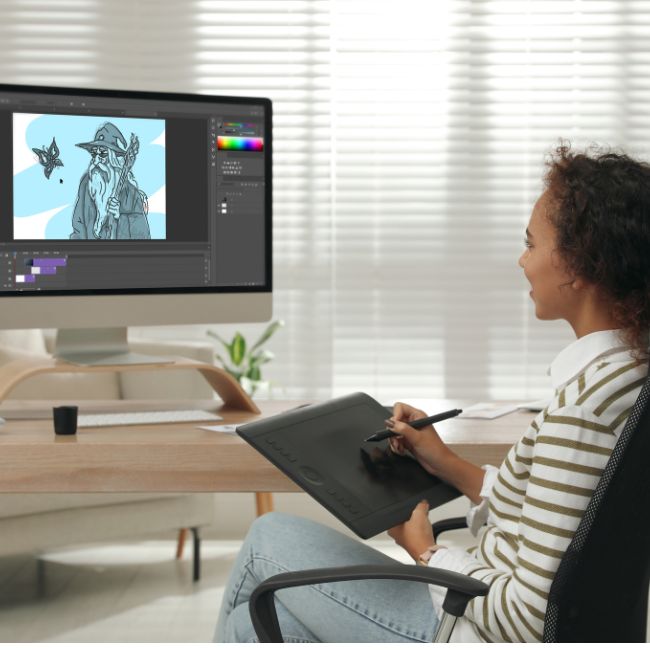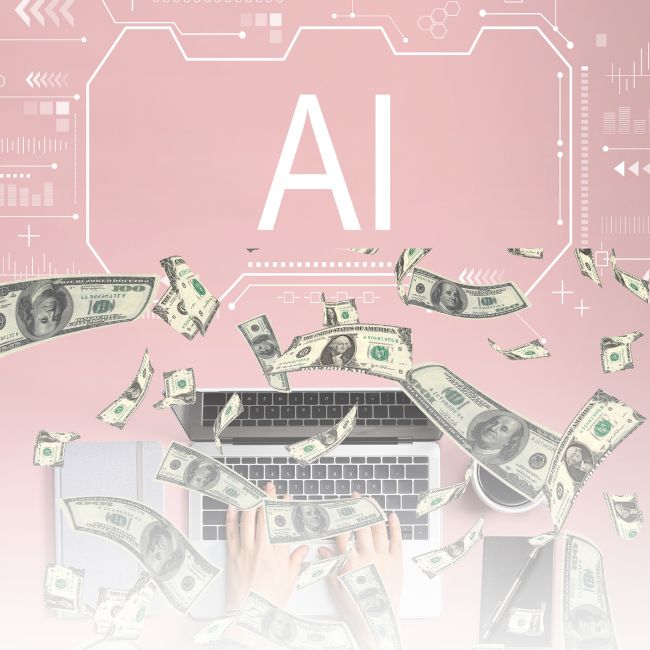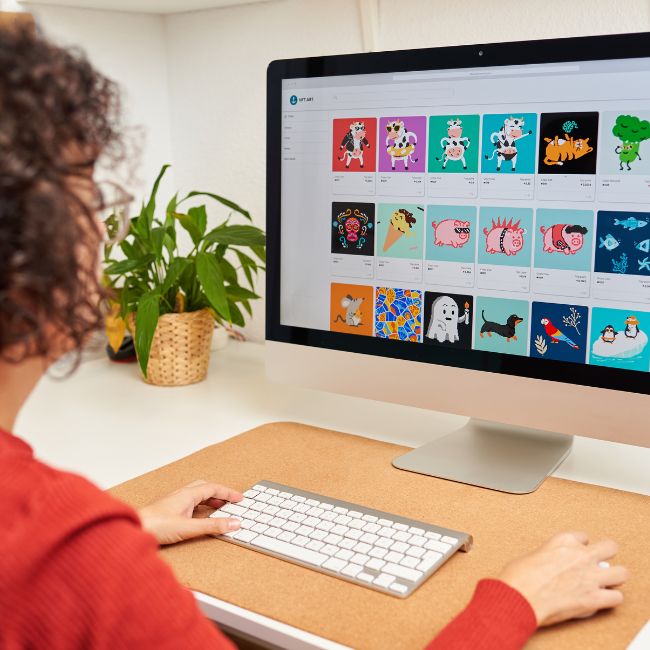The realm of artificial intelligence has opened up exciting new opportunities for artists and non-artists alike to create digital masterpieces. This has led many to ask, can you sell AI-generated art? Yes, you absolutely can! In this blog post, we will explore how much you can make, where to sell your art, and tips to create art that will actually get you sales. So, if you’re curious about the financial prospects of this innovative field and want to learn how to turn your AI-generated art into a profitable venture, keep reading!

Our number one goal is to help readers learn about strategies to build passive income using tools such as AI. We regularly partner with companies that make reaching that goal easier. If a purchase or signup is made through one of our Partners’ links, we may receive compensation for the referral at no additional cost to you. Learn more here.
How Much Money Can You Make selling ai- generated art?
When it comes to AI-generated art, there is significant potential to generate substantial income. The market for these unique digital artworks has been growing rapidly, with collectors and art enthusiasts increasingly recognizing their value. While the income potential varies depending on various factors, such as the quality and uniqueness of your art, the demand for AI-generated pieces, and your marketing efforts, there are success stories that highlight the lucrative nature of this industry.
I personally have had great success selling digital prints of my artwork on Etsy. Upwards of a few thousand dollars a month… not quite ready to retire, but I’ll take it! Being successful in this business really comes to down to producing top quality art (i.e. upscaling your work – more on this later) and choosing the right niche. There are many avenues available for selling AI-generated art, such as digital prints, NFTs, commercial use, print-on-demand products, and more. While the income potential varies greatly, with dedication and effort, it is possible to earn a full-time income from this burgeoning field.

Where can you sell ai-generated art?
Digital Prints:
One of the most accessible ways to sell AI-generated art is through digital prints. These high-resolution digital files can be sold on platforms like Etsy, Redbubble, or personal websites. Pricing can vary depending on factors like the complexity of the artwork, the artist’s reputation, and the market demand. While digital prints generally offer a lower price point, the potential for sales volume can compensate for this.
Non-Fungible Tokens (NFTs):
NFTs have gained immense popularity in recent years, providing artists with a unique opportunity to sell digital art with proof of ownership and scarcity. AI-generated art can be minted as NFTs and sold on blockchain-based platforms like OpenSea, Rarible, or Foundation. NFT sales can range from a few dollars to millions of dollars, depending on the artwork’s perceived value, rarity, and the artist’s reputation. However, it’s important to note that the NFT market can be volatile, and success is not guaranteed.

Commercial Use:
AI-generated art can also be licensed for commercial use, such as advertising, book covers, album artwork, or branding. This avenue requires actively seeking out potential clients or collaborating with agencies and companies. The income potential here can vary greatly depending on the scale of the projects, negotiation skills, and the artist’s portfolio and reputation. Commercial use can provide a steady stream of income, especially for artists who establish long-term relationships with clients. You could also offer your services on marketplaces such as Fiverr.
Print-on-Demand Products:
Another avenue for monetizing AI-generated art is through print-on-demand (POD) services. Artists can create designs incorporating their AI-generated artwork and have them printed on various products like t-shirts, mugs, phone cases, and more. POD platforms like Redbubble, Society6, or Printify allow artists to upload their designs and earn a commission on each sale. The profit margin per sale may be lower, but the potential for high-volume sales can make it a lucrative option.

Art Licensing and Collaborations:
Artists can explore licensing agreements and collaborations with companies or brands that align with their artistic style. This can involve creating AI-generated art for merchandise, home decor, or even video games. The income potential here can vary widely, ranging from one-time licensing fees to ongoing royalties. Developing relationships with companies and actively seeking out licensing opportunities can significantly boost an artist’s earnings.
AI-Generated Art That Sells: Tips for Success
Niche Research: Understanding Your Market
Before diving into the creation process, it’s crucial to conduct thorough niche research. Identifying your target audience and understanding their preferences will help you tailor your AI-generated art to their tastes, increasing the chances of making successful sales.
To streamline your niche research process, two fantastic tools you can use are EtsyHunt and Alura. EtsyHunt allows you to explore popular trends and products on Etsy, a leading online marketplace for handmade and unique items. By analyzing what’s selling well, you can gain insights into market demands and tailor your AI-generated art accordingly. Alura, on the other hand, provides detailed data on specific niches, helping you uncover profitable opportunities and stay ahead of the competition.
Embrace the Power of Upscaling
Upscaling your AI-generated art is a critical step in ensuring customer satisfaction, positive reviews, and ultimately, increased sales. Or conversely, avoiding negative reviews if a customer prints a pixelated image of yours on a larger canvas. Upscaling involves increasing the resolution and quality of your artwork without sacrificing its original essence.
By using AI-powered upscaling tools, you can enhance the visual details, textures, and overall quality of your art. The best upscaler on the market is Topaz Gigapixel AI. Gigapixel leverages deep learning algorithms to analyze and intelligently enhance your images, resulting in sharper, more refined artwork. This process significantly improves the customer’s perception of your art, making it more appealing and valuable.

Why is Upscaling Essential?
a) Visual Appeal: Upscaled art displays finer details and a higher level of precision, captivating viewers and potential buyers.
b) Print Quality: High-resolution artwork is essential for printing purposes. Upscaling ensures your art maintains its quality and integrity, even when printed in larger formats.
c) Customer Satisfaction: Upscaling enhances the overall viewing experience, leaving a positive impression on customers. Satisfied customers are more likely to provide positive reviews, recommend your art, and become repeat buyers.
d) Competitive Edge: In a saturated market, providing superior quality through upscaling can differentiate your art from competitors. This advantage can attract discerning customers seeking high-quality pieces.
Iterative Improvement: The Art of Feedback
To thrive in the AI-generated art market, it’s crucial to embrace feedback and continually improve your creations. Actively seek customer reviews, constructive criticism, and suggestions for enhancement. By analyzing feedback, you can identify areas for improvement, adapt to evolving trends, and refine your artistic style.
Leverage social media platforms, online art communities, and forums to connect with your audience and gather valuable insights. Engaging with your followers not only helps build a loyal fanbase but also provides an opportunity to understand their preferences, refine your niche, and align your art with market demands.
Conclusion
In conclusion, the sale of AI-generated art presents an exciting new opportunity for artists and non-artists alike to explore a potentially lucrative passive income stream. With the market for digital artworks growing rapidly, there is significant potential to generate substantial income from AI-generated art. Success in this field depends on various factors, including the quality and uniqueness of the art, demand for AI-generated pieces, and effective marketing efforts.
There are several avenues available for selling AI-generated art, such as digital prints, NFTs, commercial use, print-on-demand products, and art licensing collaborations. Each platform offers different income potentials and opportunities for artists to monetize their creations. Digital prints can be sold on platforms like Etsy, Redbubble, or personal websites, while NFTs can be minted and sold on blockchain-based platforms like OpenSea or Rarible. Artists can also explore licensing their AI-generated art for commercial use, collaborate with companies, or utilize print-on-demand services to sell their designs on various products.
To increase the chances of success, it’s essential to conduct niche research, understand the target audience, and tailor AI-generated art to their preferences. Upscaling the art using AI-powered tools like Topaz Gigapixel AI is crucial to enhance visual appeal, ensure high print quality, and increase customer satisfaction. Additionally, artists should actively seek feedback, engage with their audience, and continually improve their creations to adapt to evolving trends and refine their artistic style.
While the income potential of selling AI-generated art varies, with dedication, effort, and a focus on producing high-quality and marketable art, it is possible to turn this innovative field into a profitable venture. So, whether you’re an artist looking to explore new creative possibilities or someone interested in capitalizing on the booming digital art market, selling AI-generated art can be a viable and exciting path to pursue.

